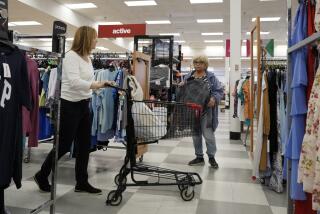Warning Signals Grow Louder for U.S. Economy
- Share via
WASHINGTON — The U.S. economy appears to be slowing more suddenly than previously thought. The slowdown increases chances that the highflying economy’s long-sought “soft landing” could turn hard, driving up unemployment and forcing the Federal Reserve to reverse course and slash interest rates.
Consumer confidence in November unexpectedly slid to its lowest level in more than a year, a respected business research group said Tuesday. Analysts, tracing the slide to the presidential election limbo and recent tumbles in the stock market, warned that it could result in weaker spending at the nation’s malls, real estate offices and auto showrooms.
Meanwhile, American businesses apparently are already pulling in their horns. A government report said orders for big-ticket manufactured goods--such as the telecommunications gear that companies have been snapping up to improve efficiency--fell an unexpectedly sharp 5.5% in October.
Analysts called the double whammy of less confident consumers and more cautious businesses the perfect recipe for slowdown. Between the two, consumers and businesses account for about 85% of the nation’s economic activity.
“These are early warning signs the expansion may finally be coming to an end,” said Edward E. Leamer, an economist and the director of the UCLA Anderson Business Forecast. “The Bush-Clinton expansion of the 1990s has lasted 38 quarters. I don’t think it will make it to 42.”
There have been signs of a slowdown for months, in no small part because the Fed jacked up interest rates six times between June 1999 and last May to put the brakes on the robust economy and guard against renewed inflation.
But most of the signs have been peripheral to the majority of Americans--a steep tumble in Internet stocks, missed corporate profit predictions, “dot-coms” gone belly up.
More recently, the warning signals have begun to flash closer to home. On Monday, the National Assn. of Realtors said home sales dropped 3.9% in October, the second decline in as many months and one that surprised economists who had thought low mortgage interest rates would keep sales rising.
On Thursday, the Labor Department said first-time claims for jobless benefits jumped to an unexpectedly large 336,000 for the previous week, substantially above the 275,000 mark where they hovered earlier this year. A sustained increase in claims is considered a harbinger of a weakening jobs picture.
“There is going to be some deterioration in the labor market. The unemployment rate is going to inch up,” predicted Robert V. DiClemente, chief U.S. economist with Citigroup’s Salomon Smith Barney Inc. in New York.
In fact, although they have not said it publicly, Fed policymakers have wanted the jobless rate to rise from its spectacularly low October level of 3.9%, for fear that wages and then prices would climb in an inflationary spiral. They have been happy to see some of the nation’s highest-flying stocks tumble back to Earth in order to avert the risk of a financial bubble.
The big question now is whether, having slowed the economy, the central bank can control the slowdown. A variety of analysts said it could, but only if it loosens its grip.
“I think we’re going to get an early Christmas present when the Fed meets,” said Richard Yamarone, chief economist with Argus Research Corp. in New York. He predicted that at its Dec. 19 meeting, the Fed’s policymaking body would drop its bias toward raising rates, and that it might start reducing rates early next year.
Investors did not appear nearly as confident of the Fed’s intentions or the economy’s prospects Tuesday. They drove the technology-heavy Nasdaq composite index down 145.51 points, or 5.1%, to 2734.98, its lowest point in 13 months. They sent the Standard & Poor’s 500 index down 1% and the Dow Jones industrial average down 0.4%.
The Nasdaq has plunged 46% from its March 10 high and is off 33% for the year.
Though stock prices fell, bond prices rose, a counterpoint movement that often signals investors are looking for a safe haven from slowdown. The price of a 10-year U.S. Treasury note rose 9/32 of a point, sending the yield or market interest rate down to a five-week low of 5.58%.
Tuesday’s reports, the latest snapshots of the economy’s condition, were largely unexpected.
After holding steady for months, the Conference Board’s index of consumer confidence dropped to 133.5 this month from 135.8 in October, the second decline in as many months.
The business group said its survey of 5,000 households found that fewer Americans planned to buy houses, cars and major appliances in the coming months, although they did not plan to cut back on holiday gift purchases.
Analysts had expected a decline of perhaps 1% in orders for big-ticket manufactured goods in October because of a computer sales slowdown and weakening exports. They were caught off guard by the Commerce Department’s report of a 5.5% drop, following September’s 2.4% increase.
Although much of the October decline was traceable to a big drop in aircraft sales, it was also fed by a 9.9% drop in orders for electrical equipment and electronics, including telecommunications and computer components.
Analysts said this is the high-tech gear corporate America has been buying to improve its efficiency and is at the very heart of the “new economy.”
More to Read
Inside the business of entertainment
The Wide Shot brings you news, analysis and insights on everything from streaming wars to production — and what it all means for the future.
You may occasionally receive promotional content from the Los Angeles Times.










